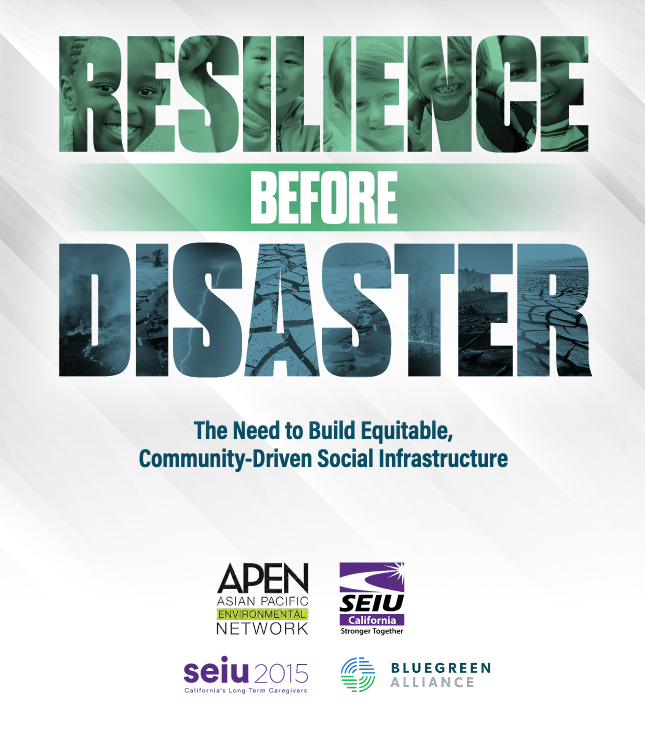PUBLISHED SEPTEMBER 2020
Resilience Before Disaster: The Need to Build Equitable, Community-Driven Social Infrastructure, jointly released by APEN, SEIU California, and BlueGreen Alliance, makes the case for California to make long-term and deep investments in the resilience of its most vulnerable communities.
As California faces devastating wildfires, extreme heat, power outages, and an ongoing pandemic, the need to proactively advance climate adaptation and resilience is more clear than ever. However, these efforts typically focus on improving hard infrastructure–roads, bridges, and other physical infrastructure–to the detriment of social infrastructure, the people, services, and facilities that secure the economic, health, cultural, and social well-being of the community.
Traditional models of disaster planning have also proven deeply inadequate: They are coordinated through militarized entities like local sheriff’s departments and rely upon protocols like evacuating to faraway and unfamiliar sites, sharing emergency alerts in only one or two languages, and requiring people to present identification to access services, thus shutting out many from the support they need.
Through these crises, we’ve seen new models of disaster response emerge. In some places, neighbors have formed mutual aid networks to share their resources with one another, schools provided food to tens of thousands of families each day, and libraries were turned into cooling centers during extreme heat waves. What these approaches have in common is that they are rooted in the existing social and public infrastructure of communities.
This report provides a policy framework for community resilience by building out models for Resilience Hubs and In-Home Resilience. This dual approach to resilience captures the need for both centralized spaces and distributed systems that promote resilience within a community. Importantly, these are not models for just disaster response and recovery. Resilience is built before disaster.
RESILIENCE HUBS are physical institutions that offer space for community members to gather, organize, and access resilience-building social services on a daily basis, and provide response and recovery services in disaster situations. The report highlights RYSE Youth Center, a youth-led community center in Richmond, which is taking the first steps toward becoming an innovative Resilience Hub model by exemplifying a youth-driven approach to infrastructure development and program delivery.
IN-HOME RESILIENCE outlines a community’s socially embedded systems, patterns, and practices that increase community members’ capabilities and support new growth in response to crisis while staying in place. The report also highlights the critical role of homecare workers who are on the frontline of in-home resilience by offering unique skills to assist those with access and functional needs and constituting a network between the populations they serve and public and community agencies. In addition to improving quality of life for homebound populations, they also represent an untapped group of skilled workers that could play an increased role in the event of disaster.
The report offers a set of recommendations representing initial steps to build resilient communities throughout California. If taken, these steps would represent an unprecedented effort to close the climate gap and invest in social infrastructure for climate resilience. These include:
- Fund Resilience Hubs: California should lead funding efforts to support the development of Resilience Hubs – spaces where communities gather, organize, and access social services on a daily basis – starting in communities with the highest need. These spaces must be equipped to provide support for disaster response and recovery. The report highlights RYSE Youth Center, a youth-led community center in Richmond, which is taking steps toward becoming an innovative Resilience Hub model by exemplifying a community-led governance approach to infrastructure development and program delivery.
- Establish Resilience Hubs Networks: City and County governments should facilitate the development of local Resilience Hubs to implement community resilience solutions on a regional scale, share best practices, and offer complementary services.
- Invest in the Care Workforce: Home care workers already have the skills and relationships to assist people with access and functional needs, and often bridge the gap between the populations they serve and public and community agencies. A well-trained and empowered home care workforce can play a key role in disaster preparedness and response and bolster In-Home Resilience for the people they serve. The state should implement strategies to turn these difficult low-wage jobs into high road careers.
- Rebuild the Public Sector Workforce: We must commit to growing a robust public sector workforce capable of meeting the needs of vulnerable populations and supporting community resilience. We need a full complement of public health, human services, public works, library, school, parks and recreation, and sustainability workers to achieve our climate goals.
- Improve Emergency Response to Protect the Most Vulnerable: The state must target resources to the most vulnerable communities, particularly working-class communities of color who are disproportionately impacted by systemic racism and historic economic disinvestment. The state must also develop a comprehensive strategy for protecting medically vulnerable populations in the event of power shutoffs and increase funding for initiatives to improve disaster preparedness and emergency response efforts for California’s vulnerable populations.


